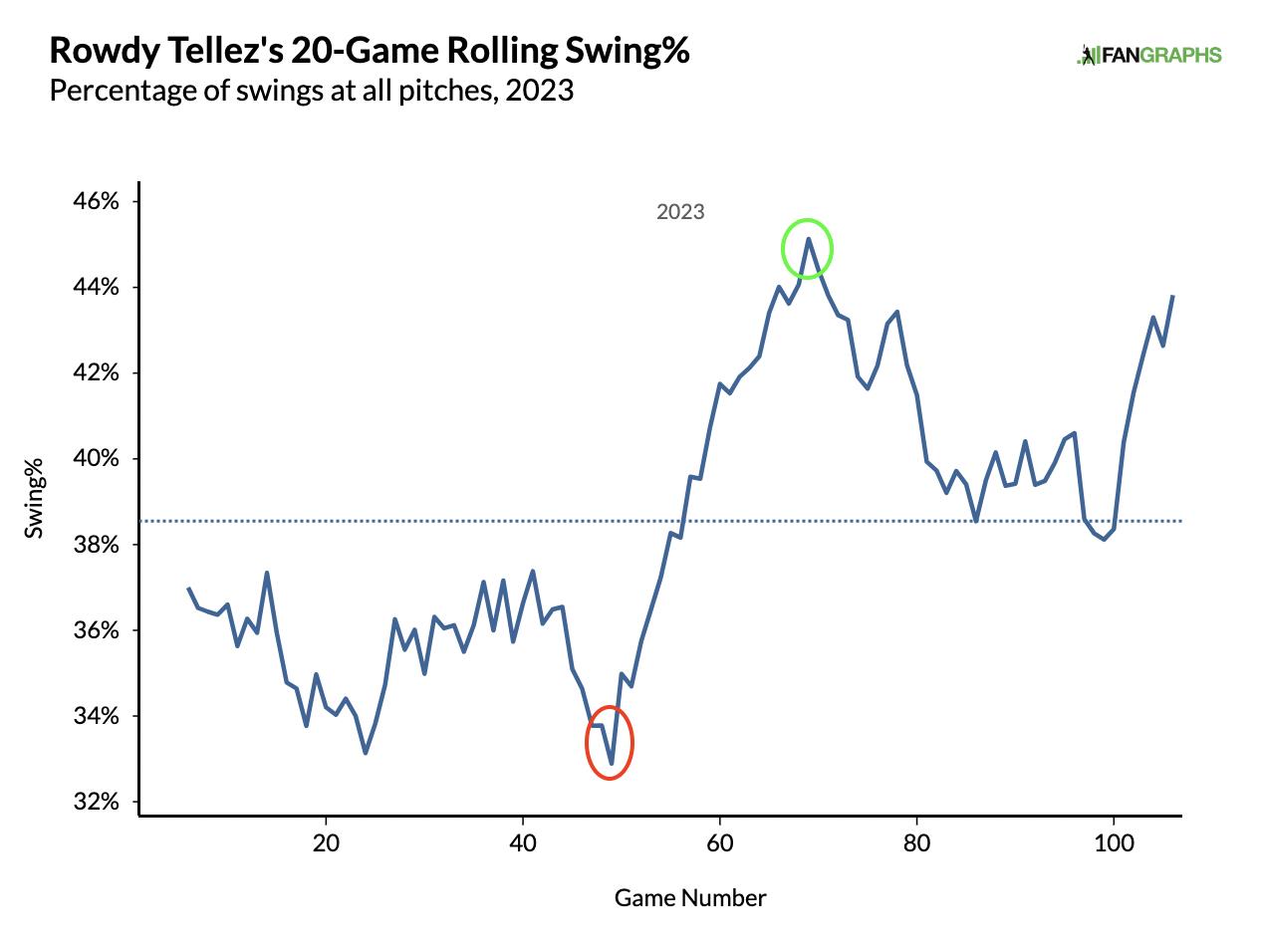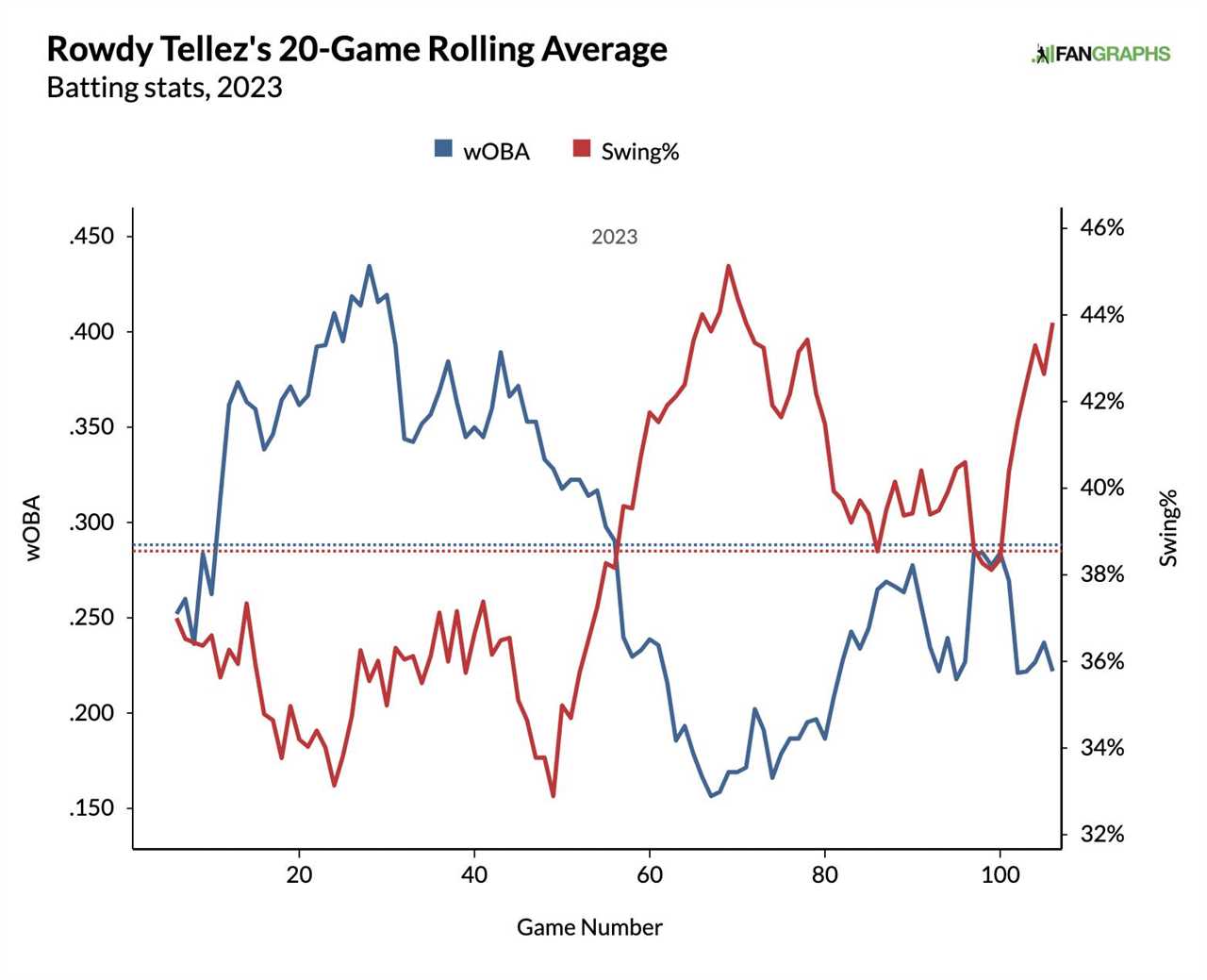
Mark Hoffman/Milwaukee Journal Sentinel/USA TODAY NETWORK
A month after Rowdy Tellez was non-tendered by the Brewers, the first baseman signed with the Pirates to little fanfare. It’s not hard to see why that particular transaction flew under the radar. Back in the good old days of December, the offseason was at its peak. There were more pressing concerns than a player with exactly 0.0 career WAR joining a rebuilding club. Yet two months later, amidst the dullest stretch of the winter (and perhaps a bout of offseason-induced delirium), I have realized we made a dreadful mistake. FanGraphs has cursed Rowdy Tellez, and now it falls on my shoulders to reverse the spell. Let me explain.
It seems like every time someone at FanGraphs writes about Tellez’s success, he falls into a slump shortly thereafter. It started when Jay Jaffe wrote about Tellez during his Davis Schneider-esque cup of coffee with the Blue Jays in 2018. The following season, Tellez disappointed, posting a 91 wRC+ and -0.3 WAR. A few years later, Jay dared to cover Tellez’s hot start to the 2022 campaign. The slugger promptly began to struggle after the article went live, going 2-for-24 over the next week. Ultimately, he posted a 100 wRC+ for the rest of the season, production too modest for a bat-only first baseman. Most recently, Chris Gilligan wrote a fascinating piece about Tellez last June. At the time, the 28-year-old was off to a smashing start to the season, fueled by a patient approach at the plate:
Rowdy Tellez has stopped swinging. Not entirely; he’s tied for ninth in the National League with 12 home runs and 20th with a .494 slugging percentage. But this year, the Brewers slugger has cut at just 35.3% of all pitches, the second-lowest rate in baseball after the famously choosy Juan Soto. It’s uncharacteristic of Tellez, representing an eight-point drop from last year and a 13.2-point drop from his 2021 campaign.
Yet sure enough, as soon as that article hit the homepage, everything changed. In fact, it seems like the curse is only growing stronger. Take a look at the graph below:

The lowest point on the graph, circled in red, represents Tellez’s rolling 20-game swing rate entering play on May 31, the day Chris pitched his article. It’s the lowest swing rate Tellez has posted in any 20-game span of his career and represents the culmination of a trend that began at the very beginning of the 2022 season. The steep upward climb from the red to the green circle represents his next 20 games that year. It’s not as if Tellez turned into a free swinger all of a sudden, but his swing rate went from extreme outlier to essentially ordinary. Through May 30, only Soto had a lower swing rate (min. 150 PA). Yet from that point to the end of the season, 53 other batters swung less often than the Brewers first baseman.
On May 31, Chris’s draft appeared on the backend of the FanGraphs website. “Can Rowdy Tellez Get More By Swinging Less?” the title asked. That evening, Tellez saw 19 pitches. A powerful force beyond his control compelled him to swing at 10 of them. It marked the first game in which he swung at over half the pitches he saw in nearly four weeks. Two days later, the finished piece appeared on FanGraphs, with Tellez’s picture at the top. That same day, he saw 13 pitches and swung at eight. His 61.5% swing rate was his highest in a single game (min. 2 PA) since the previous summer. All of a sudden, as if cursed by dark magic, Tellez had left his patient approach by the wayside. And it’s not as if he did so with good reason. Quite the opposite, in fact. From that point on, his strong season crumbled before his eyes.
Through May 30, Tellez had played 49 games. He was walking 12.2% of the time. His 12 home runs and 123 wRC+ were tops among qualified Brewers hitters. Then, from May 31 through the end of the year, he played another 57 games. His walk rate fell to 7.6%, and he added just one more home run. No other National League hitter (min. 150 PA) had a lower wRC+ than his 31. I can’t guarantee his new swing tendencies brought about his downfall, but I can certainly show the correlation:

The traditional markers of poor plate discipline — a low walk rate and high strikeout rate — weren’t the root of Tellez’s struggles. His strikeout rate was unchanged, as all his extra swings merely canceled out his called strikes from earlier in the season. Moreover, his 7.6% walk rate wasn’t that far below league average, nor was his 0.31 strikeout-to-walk ratio. Instead, the real trouble came when he put the ball in play. A hitter defined by his power suddenly found himself powerless, hitting lazy fly balls instead of driving pitches into the seats.
Brute strength wasn’t the issue; Tellez could still pummel the baseball. For the fifth year in a row, he finished in the 94th percentile or higher in maximum exit velocity, and his hardest-hit ball of the year came in July. In fact, his three hardest-hit balls of the season all came after May 31. Even so, he wasn’t doing nearly as much damage as he had earlier in the season; in truth, he wasn’t doing any damage at all. Although he put more balls in the air, those balls were far less likely to be hit hard. Instead, he was hitting more cans of corn to the opposite field and more popups to the infield. His barrel rate plummeted, and more often than not, those barrels were replaced by the kind of contact Statcast classifies as “poorly/under” hit. In addition, he was hitting more foul balls, and not just as a means of staying alive with two strikes. It’s pretty clear Tellez was struggling to see pitches and swing at the right offerings. Yet he continued to swing.
William of Ockham might point to a simpler explanation than dark magic. What if opposing pitchers adjusted to Tellez’s new approach, forcing him to swing more often by throwing more pitches in the strike zone? It’s a plausible hypothesis, I’ll give William that, but the numbers don’t support it. Tellez didn’t see a change in his overall zone rate after May 31. The only zone in which he saw significantly more pitches was the chase zone.
What’s more, he increased his swing rate across the board. He swung more often at pitches in the heart zone, the shadow zone, the chase zone, and the waste zone. He swung more often at fastballs, offspeed pitches, and breaking balls. He swung more when he was ahead in the count, when he was behind in the count, and when the count was even. None of those swings did him any good, either. As you could probably guess from his overall numbers, he produced negative value on swings in all four attack zones, against all three pitch types, and regardless of the count. Simply put, it looked as if Tellez was compelled to swing, regardless of the outcome. He was cursed.
Perhaps you think a physical injury is a stronger explanation than a curse. After all, Tellez spent about six weeks on the injured list last summer, first with forearm inflammation and then with a torn nail. After the season, he suggested he had been playing through pain, telling reporters, “I think that once [the injuries] happened – and then trying to deal with the injuries and not saying anything and just being that guy that goes out every day whether it’s right or wrong – just kind of rolling through it really affected me.”
Even if his arm started to bother him more than a month prior to his eventual IL stint (and his finger continued to bother him long after he returned), it’s a little odd that he would swing more often as a result. If Tellez were trying to reduce his pain or compensate for diminished strength, one might expect him to swing even less. Instead, he caused himself greater pain in exchange for worse results. It reads like a punishment from Greek mythology. Or, you know, like a curse.
If Tellez is going to get back on track this year, he has to hit for power. Steamer projects him for a 106 wRC+, while ZiPS has him at 92. The only considerable difference between those two projections? Steamer is confident he can rediscover his plus power. To accomplish that, he has to make better contact, and one way he can do so is by laying off pitches he can’t hit. Thus, Tellez needs to reverse the FanGraphs curse. If writing about his success portends his failure, I hope that writing about his struggles will have the opposite effect.
Source
https://blogs.fangraphs.com/reversing-the-rowdy-tellez-curse/
 Backyard GrillingWeekend WarriorsAdvice from DadBeard GroomingTV Shows for Guys4x4 Off-Road CarsMens FashionSports NewsAncient Archeology World NewsPrivacy PolicyTerms And Conditions
Backyard GrillingWeekend WarriorsAdvice from DadBeard GroomingTV Shows for Guys4x4 Off-Road CarsMens FashionSports NewsAncient Archeology World NewsPrivacy PolicyTerms And Conditions
